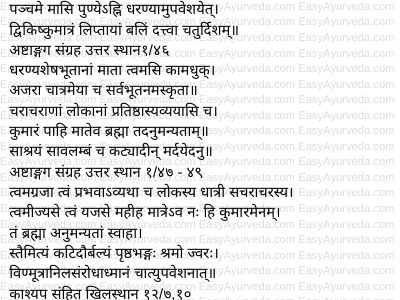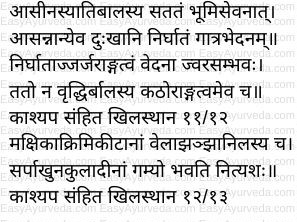Child Sitting Ceremony: Upaveshana Samskara
By Dr Raghuram Y.S. MD (Ay) & Dr Manasa, B.A.M.S
Upaveshana is one of the measures of infant care which would be done in the first six months of the child’s life. Though it is not included in the 16 samskaras i.e. ceremonies it is an important milestone in the life of the child. Here the child is made to sit.
Upaveshan – to seat, to make someone sit
Sanskar – ceremony / ritual
Table of Contents
Introduction
These are the first attempts towards making the child sit and to gradually make a practice of doing so regularly. This is an important step and indicator towards the development of motor skills in the child.
It is observed that the child sits for about 30 seconds with support in the fifth month and without support in the sixth month. From this point the child starts to make it a practice to sit for longer duration and gradually gets accustomed to doing it.
In Ayurveda, the sitting of the child is also carried out in a ceremonious way. It is the first occasion in which the child independently sits on the lap of his or her mother / wet nurse.
Read – Symptoms That Hint Towards Different Diseases In Babies

Time
Vrddha Vagbhata has advocated ‘sitting ceremony’ to be conducted in the 5th month after birth and Master Kashyapa opines that this shall be carried out in the 6th month.
Master Vagbhata says that the child should be trained to sit on the ground from 5th month onwards. This means that the process of making the child sit on the ground should be started in the 5th month in the presence of parents or a wet nurse. This should be done on an auspicious date and position of the star.
Read – Infant Care As Per Ayurveda: Initial 6 Months
A selected area of the ground should be smeared with cow dung. Worship of gods and offerings to them should be done in all four directions and the child should be made to sit on the region of the ground smeared with dung.
While conducting the puja – worship, the below mentioned hymn should be chanted –
Meaning – ‘Oh Mother Earth, You behold all the living beings in your lap. You fulfill the dreams and desires of everyone connected to you. You are devoid of senility. You are beyond the scope of everything and all pervading and omnipresent. You give shelter unconditionally to all the living and lifeless things. You are unchangeable and non-destructible. All living beings salute, respect and worship you. You kindly protect this child just like a mother. And may Lord Brahma acknowledge you’.
Before bringing the sitting of the child to practice, the above said hymn should be recited daily in the presence of the child. Water enchanted with this hymn should be put on the ground. In the beginning the child may feel tiresome to sit since it is something new to the child. But the child will never stop trying and will do it with curiosity. The process will impart severe pressure on the hips and related parts of the body engaged in sitting, muscles, bones, everything.
Read – 5 Things Not To Do To Your Child
Therefore, Master Vagbhata advises as explained below.
Care to be taken while seating the child
The child should be made to sit for a short duration at the beginning. One should not make the child sit for longer duration right at the start.
One should make sure that the child is supported at all sides by soft pillows or cushions. The mattress on which the child is seated also should be comfortable and smooth.
The child should be carried in hands and carefully made to sit with the support. One should not leave the child from the grip of their hands until the child has been seated comfortably. This will avoid the child from falling down to the sides or front. One should also stay in front of the child until the child learns and enjoys sitting. Else the child would get scared if left alone because sitting is a new habit.
After a brief spell of seating the child, one should give a soothing massage to the back, waist and legs of the child with herbal oil.
Read – Benefits Of Sitting Straight – How To Sit Straight For A Long Time?
Method
Method of seating the child as explained by Master Kashyapa
1. Pre-rituals
– An auspicious day is selected for this ritual in the 6th month.
– Worship should be offered to Gods. Brahmins should be served with good food and offerings to their satisfaction.
– Hymns should be offered for the welfare and health of the child and also for the auspiciousness of the ritual.
2. Selection of place for seating the child
– An auspicious place should be selected for seating the child.
– A platform for seating the child shall be installed at the center of a big hall, room, verandah or a clean ground in the premises of the home.
– It should be of the dimension of 4×4 feet, circular or square in shape.
– The selected area shall be cleansed and smeared with cow-dung.
3. Arrangements around the platform
– Attractive pieces of gold, silver, copper, brass, lead and iron
– All kinds of gems, pearls, corals
– Rice and grains
– All kinds of rice, dishes, milk, curds, ghee, cow dung, cotton etc
– Edibles prepared with flour
– Soft toys of the shape of many kinds of animals, birds, fruits, vegetables etc
– Other toys of the shape of stone / mountain, house, chariot, vehicle, fountain, waterfalls, feeding mother, male child etc and other toys which are likable for women should be kept around the platform
4. ‘Seating of the child’ ceremony
The below mentioned hymn should be enchanted and enchanted water should be offered to the earth.
Meaning
‘Oh Divine Earth, your origin and existence is before everything and everyone. Your origin is of utmost sacredness and divine and there is no destruction for you. You behold and nurture all the living and inert beings. We offer you worship and fire sacrifice with utmost respect and reverence. We pray that you protect this child of ours. May Lord Brahma, the creator of the world be a witness of this and also approve this.’
After this, the child who has been given a bath, decorated and made to wear new clothes should be made to sit at the center of the platform comfortably, facing east. The child should be seated for a short duration.
After sitting there for some time the child would touch or hold one of the objects placed around the platform. Whichever object the child touches, the child is said to be related to and belong to that object.
Following this, the wet-nurse should lift the child in her arms with kindness and compassion. She should allow the child to play with other children of the same age and entertain him / her.
In this way the child should be put into practice of sitting for a short duration following the rituals. The duration of sitting should be gradually increased and the child trained until the child is capable of sitting comfortably without fear.
One needs to note that the child will be able to sit only when the muscles of the pelvis, back and legs / lower limbs have properly developed. This happens for 5 months. Therefore the child should be trained to sit from the end of 5th month or 6th month onwards. One should not force the child to sit before this. It will not benefit the child; instead it may have awkward effects.
Read – Analysis Of Effect of Mantras On Health And Nadi
Sanskrit Verses


Effects
Effects caused due to excessive sitting in children
If the child is forcibly made to sit for long duration it may have untoward effects. They include Numbness and loss of movements
Weakness in the pelvis / waist
Crookedness or bending of the back
Fatigue
Fever
Obstruction to passage of feces, urine and fart
Flatulence / bloating
Therefore the child should be gradually trained to sit for short periods of time and gradually the duration should be increased until the child becomes comfortable and confident enough to sit all by himself.
Nirghata and Angabheda
When an infant is made to sit for longer duration repeatedly, the child very quickly becomes a victim of diseases named nirghata and angabheda.
Nirghata is a condition wherein due to excessive shaking; the body of the child becomes weak and hurt as if broken. The child suffers from body pain and fever. The development of the child is halted and the body parts will not attain compactness and stability.
Angabheda is a condition in which the child suffers from splitting pain in the body parts.
Other effects
When the child sits for a longer duration at a place there is a fear of
the child getting bitten / stung by flies, insects, snakes, scorpions, mongoose etc.
the child being afflicted by a strong and fierce breeze.
Click to Consult Dr Raghuram Y.S. MD (Ayu)









